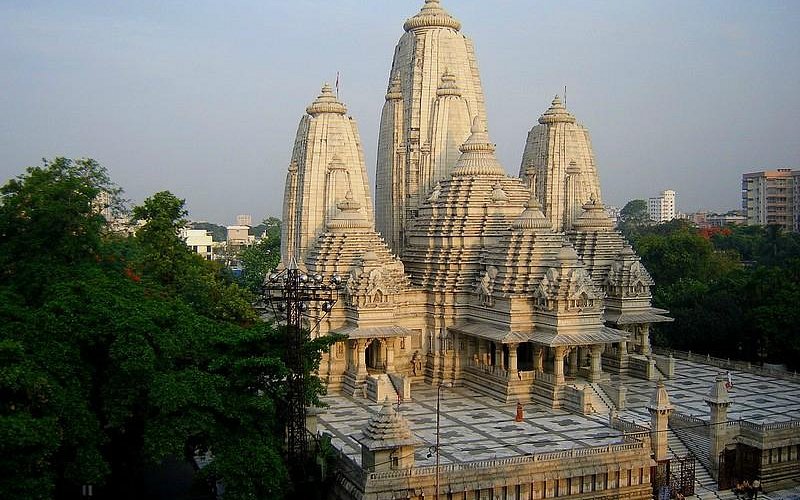On the edge of Gurusaday Road in Ballygunge, South Kolkata, West Bengal, Birla Mandir stands as a divine shrine dedicated to Lord Krishna and Radha, worshipped as Lakshmi Narayan. Built in 1996 by the Birla family, it is a sacred site tied to Vaishnava devotion. The construction of the temple began in 1970 and took 26 years to complete the entire structure.
Key Highlight: The temple’s 8-foot white marble Lakshmi Narayan idols, adorned with gold and silk, mark it as a grand Vaishnava hub, its grand structure a testament of devotion.
History of Birla Mandir
Birla Mandir, completed in 1996 after 26 years of work, was built by the Birla family, known for temples across India. Started in 1975 under B.M. Birla’s vision, it was opened by G.D. Birla’s son, B.K. Birla. A marble plaque names the family’s role, costing 18 crore rupees. Designed to spread Krishna devotion, it draws thousands daily, holding a big place in Kolkata’s holy land of worship. Vaishnava texts say Krishna, with Radha, is the eternal divine couple, worshipped as Lakshmi Narayan here. The temple, though modern, ties to Bengal’s devotion to Krishna, rooted in Chaitanya Mahaprabhu’s 15th-century teachings. The Birlas, inspired by India’s temple heritage, built it to honor Krishna’s love and grace. Devotees believe Lakshmi Narayan bless devotees with peace and prosperity.
Architecture of Birla Mandir
Covering 2 acres(44 kathas) in Ballygunge, Birla Mandir uses North Indian Nagara style with a 160-foot shikhara, made of white Rajasthan marble. This white marble temple shares architectural similarities with the famous Lingaraj Temple in Bhubaneswar. The structure features stone carvings that illustrate scenes from the Bhagavad Gita and incorporates detailed elements of traditional Rajasthani temple design. The temple was designed by architect Nomi Bose. The main shrine, 12 meters by 12 meters, holds Lakshmi Narayan idols. Side shrines for Shiva, Durga, and Hanuman, each 5 meters by 5 meters, stand nearby. The entry, a 10-meter gate with carved elephants, opens to a marble yard, 2000 square meters, for thousands. Stone panels on the walls show Krishna’s tales, polished in marbles.
Sculptures and Carvings
The temple’s heart is 8-foot white marble Lakshmi Narayan idols—Krishna with a flute, Radha with a lotus, draped in silk and gold. A 3-foot Shiva linga, black stone, rests in the Shiva shrine. The Durga shrine, 100 meters off, has a 4-foot Durga idol, golden stone. Marble panels, 1 meter by 0.5 meters, show Krishna’s life from Gita scenes, Radha’s love carved in Jaipur. The right side dome of the temple houses statue of Shiva in deep meditation.
Rituals and Worship
Worship starts at 5:30 AM with priests offering tulsi, flowers, and incense. At noon, rice, dal, vegetables, and sweets like peda are offered. Big pujas happen at Janmashtami, Radhashtami, and Diwali, with kirtans and night bhajans. On Janmashtami, idols get peacock feather crowns. People offer bhog and take prasad. The Janmashtami festival in August has folk songs and old Vaishnava traditions since the temple’s start.
Travel Information
Getting to Birla Mandir
In Ballygunge, 7 km from Kolkata’s center, the temple is reached by metro, bus, or taxi, near Gurusaday Road.
By Air: Kolkata’s airport, 20 km away, joins Delhi (2 hours), Mumbai (2.5 hours), Chennai (2.5 hours). Taxis take 40 minutes, ₹500–1000.
By Train: Sealdah Station, 5 km away, links to Howrah (15 minutes, ₹5–20). Autos or taxis take 15 minutes, ₹30–100. Ballygunge Junction, 2 km away, works too.
By Road: Ballygunge joins Kolkata (7 km, 20 minutes), Howrah (10 km, 25 minutes), Esplanade (6 km, 15 minutes) via AJC Bose Road. Buses cost ₹15–40, taxis cost ₹150–400. Autos cost ₹20–50, no steps to enter.
Hours and Entry
Open daily, 5:30 AM–11:00 AM, 4:00 PM–9:00 PM. Free entry with puja costing ₹100–1000. No phones or cameras inside but can be kept in lockers at temple counters. Wear clothes covering shoulders and knees women in sarees or suits, men in kurtas or dhotis. Stalls sell puja items nearby.
Best Time to Visit
October to March, 12–25°C, is good for visits. Janmashtami (August), Diwali (November), and Radhashtami (September) bring crowds so better to go at dawn. Skip April–June, 25–40°C, for less heat and fewer people.
Nearby Places
Kalighat Kali Temple, 3 km, historic Kali shrine.
Victoria Memorial, 4 km, 1921 marble museum.
Rabindra Sarobar, 2 km, serene lake and park.
Alipore Zoo, 3 km, old zoological garden.
Birla Planetarium, 4 km, 1963 star observatory.
Cultural Weight
Birla Mandir shows Kolkata’s Vaishnava and modern devotional roots. Janmashtami, with kirtans and dances, keeps Bengal’s old traditions alive. Priests and locals unite for festivals, building unity. Nearby stalls sell Bengali sweets like sandesh and vegetarian bhog, adding to the visit.
Final Thoughts
Birla Mandir in Ballygunge, Kolkata, West Bengal, showcases the holy traditional heritage of hindu culture. Lord Krishna and Radha’s gentle presence, by the city’s bustle, moves those who come, and provides peace making it a place you must see among India’s sacred sites for devotees and travelers alike.











